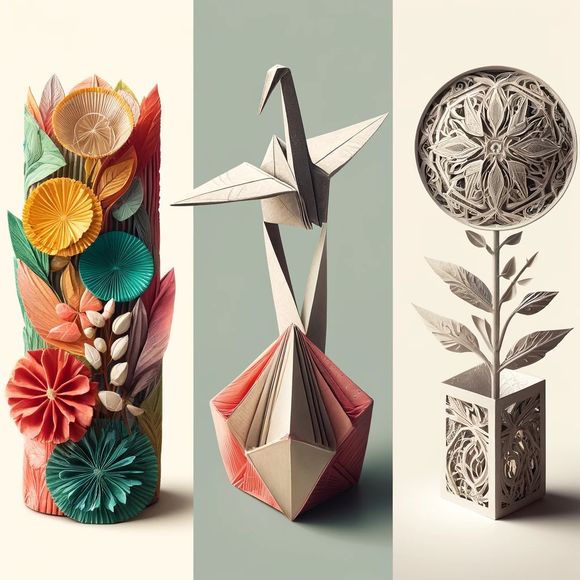Paper, a ubiquitous material often taken for granted, holds within its humble form an extraordinary potential for artistic expression. From the delicate folds of origami to the intricate designs of papercuts, and the three-dimensional creations of paper mâché, paper transforms into captivating works of art. While each form possesses its unique charm and challenges, a comparative exploration reveals their distinct characteristics, creative possibilities, and historical significance.
Origami: The Art of Folding
Origami, the Japanese art of paper folding, embodies a harmonious blend of simplicity and sophistication. With a single sheet of paper as the canvas, origami artists meticulously manipulate folds, creases, and edges, breathing life into intricate shapes and forms. From the iconic crane to complex modular structures, origami creations showcase the boundless creativity that can emerge from a simple square of paper.
The allure of origami lies not only in its visual appeal but also in its meditative process. Each fold demands focus and precision, fostering a sense of mindfulness and tranquility. Origami practitioners often find solace in the rhythmic movements, immersing themselves in the present moment as they transform paper into art.
Papercut: The Delicate Dance of Precision
Papercut art, with its intricate filigree patterns and intricate details, exudes an air of delicate beauty. Using sharp blades or specialized tools, papercut artists meticulously carve intricate designs into sheets of paper, creating mesmerizing works of art that play with light and shadow.
The allure of papercut art lies in its captivating contrast between the delicate fragility of paper and the intricate precision of the designs. Papercut artists transform the humble material into intricate lacework, snowflakes, or elaborate portraits, showcasing the transformative power of art.
Paper Mâché: Sculpting with Paper
Paper mâché, with its three-dimensional forms and malleable nature, offers a unique avenue for artistic expression. By layering strips of paper or papier-mâché pulp onto a base, artists create sculptures, masks, and decorative objects that can range from whimsical to lifelike.
The charm of paper mâché lies in its versatility and accessibility. Simple household materials, such as newspapers, glue, and balloons, can serve as the foundation for remarkable creations. This approachability makes paper mâché a popular art form for crafters, hobbyists, and even children.
A Comparative Overview
| Feature | Origami | Papercut | Paper Mâché |
|---|---|---|---|
| Medium | Single sheet of paper | Multiple sheets of paper | Paper strips or papier-mâché pulp |
| Technique | Folding | Cutting | Layering and sculpting |
| Dimensions | Two-dimensional | Two-dimensional or three-dimensional | Three-dimensional |
| Visual Appeal | Geometric shapes, intricate patterns | Delicate designs, play of light and shadow | Sculpted forms, realistic or whimsical |
| Creative Process | Meditative, focused | Precise, detail-oriented | Sculptural, imaginative |
| Historical Significance | Ancient Japanese tradition | Rooted in folk art and storytelling | Diverse origins, used for decorative and functional purposes |
Conclusion: A Tapestry of Artistic Expression
Origami, papercut, and paper mâché, each with their unique characteristics and artistic expressions, offer a testament to the versatility and transformative power of paper. From the meditative folds of origami to the intricate designs of papercuts and the three-dimensional creations of paper mâché, these art forms invite exploration, creativity, and a deeper appreciation for the humble medium of paper. Whether gracing galleries or adorning homes, these paper-based masterpieces serve as enduring reminders of the boundless potential that lies within a simple sheet of paper.
